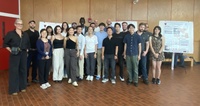Citation:
154., Suji Choi, Keel Yong Lee, Sean L. Kim, Luke A. MacQueen, Huibin Chang, John F. Zimmerman, Qianru Jin, Michael M. Peters, Herdeline Ann M. Ardoña, Xujie Liu, Ann-Caroline Heiler, Rudy Gabardi, Collin Richardson, William T. Pu, Andreas R. Bausch, and Kevin Kit Parker. 7/27/2023. “
Fibre-infused gel scaffolds guide cardiomyocyte alignment in 3-D printed ventricles.” Nature Materials, 22, Pp. 1039 – 1046.
Publisher's VersionAbstract:
Hydrogels are attractive materials for tissue engineering, but efforts to date have shown limited ability to produce the microstructural features necessary to promote cellular self-organization into hierarchical three-dimensional (3D) organ models. Here we develop a hydrogel ink containing prefabricated gelatin fibres to print 3D organ-level scaffolds that recapitulate the intra- and intercellular organization of the heart. The addition of prefabricated gelatin fibres to hydrogels enables the tailoring of the ink rheology, allowing for a controlled sol–gel transition to achieve precise printing of free-standing 3D structures without additional supporting materials. Shear-induced alignment of fibres during ink extrusion provides microscale geometric cues that promote the self-organization of cultured human cardiomyocytes into anisotropic muscular tissues in vitro. The resulting 3D-printed ventricle in vitro model exhibited biomimetic anisotropic electrophysiological and contractile properties.
